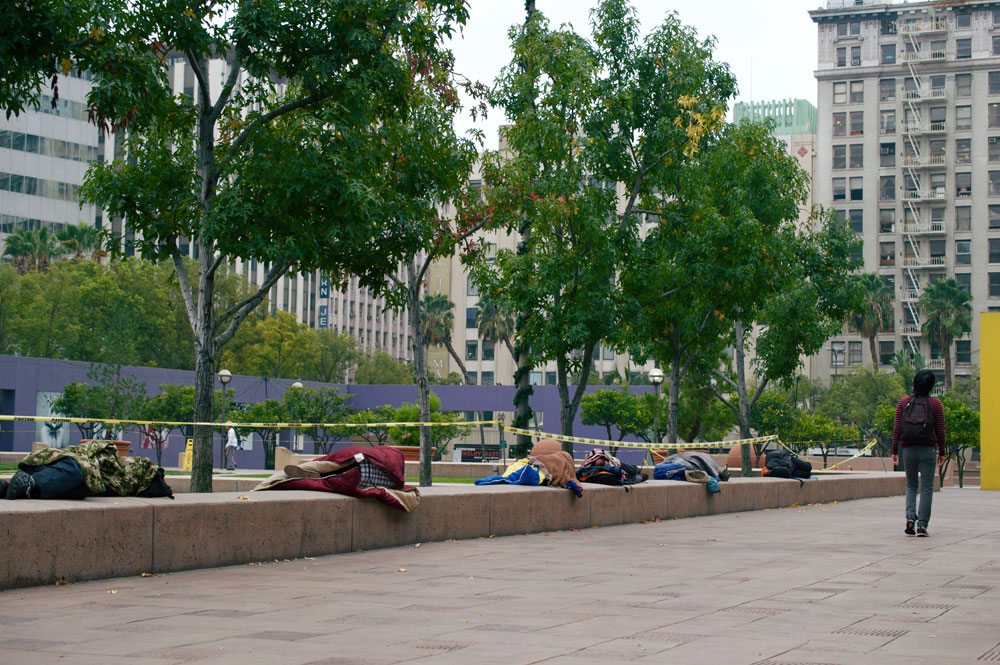
June 18, 2019; KABC-TV
In Los Angeles, the epicenter of “a particularly brutal style of homelessness” in which 75 percent of homeless people are unsheltered, the attention often goes to inner-city areas such as downtown, Mid-Wilshire, and Hollywood, where anyone can see homeless people on the streets. Striking video footage produced by local ABC affiliate Channel 7 Eyewitness News showed tent encampments throughout the San Fernando Valley, a 260-square-mile suburban expanse with agricultural roots to the northwest of downtown L.A.
The news reporter interviewed Ken Craft, the founder of San Fernando Valley Rescue Mission, which operates a 90-bed family shelter in Northridge, who called the news video of tent cities in parks and by a river “sobering” and “shocking.” His eyes downcast, he said this “reminds you that there’s 8,000 people that do not have a house to live in just in the San Fernando Valley. And that’s not okay.”
Another nonprofit organization, L.A. Family Housing, based in North Hollywood in the San Fernando Valley, works to reduce homelessness by connecting people to services using “evidence-based best practices” and developing low-income housing. They now serve 11,000 people annually “and operate 26 properties of temporary, permanently affordable, and permanent supportive housing across Los Angeles.”
Such painstaking efforts to build housing and serve homeless people by longstanding nonprofits—L.A. Family Housing started as an interfaith collaboration to stop increasing homelessness in 1983—are not turning the tide, dwarfed by the scale of the problem. Today, the official homeless count of L.A. City, which includes the San Fernando Valley, is at 36,300. There are 11,086 people living in tents and makeshift shelters, up by 17 percent.
Homelessness in L.A., including the San Fernando Valley, has been worsening for at least the last 35 years. As a reference point, the author began her career in 1989 with a nonprofit that acquires old hotel buildings on Skid Row to create high-quality first-rung housing for struggling folks. Already, there was cooperation and exchanges among diverse organizations addressing homelessness in Skid Row. We shared a feeling that the status quo was unacceptable, and the solutions were adequate for the scale of the problem and the business of serving the homeless didn’t feel so permanent, yet.
Sign up for our free newsletters
Subscribe to NPQ's newsletters to have our top stories delivered directly to your inbox.
By signing up, you agree to our privacy policy and terms of use, and to receive messages from NPQ and our partners.
Supported by public funding allocations and private donations, the homeless service infrastructure is as permanent as any nonprofit organization aiming for effectiveness. The solutions, however, clearly do not match what has become an emergency. The systemic and protracted nature of homelessness raises a question—what other roles besides providing services and housing and advocating for vulnerable people might nonprofits play to get the city moving towards visibly affecting the problem?
The Channel 7 reporter, as others have, describes homelessness as a complex problem. However, it may have become complex over time only because systemic solutions that were apparent when problems began to appear did not become reality. An example is the way the lack of public mental health structure contributed significantly to the homelessness crisis. In the 1980s, homeless service organizations already knew that a segment of the population they serve is mentally ill because community mental health centers the Reagan administration promised after closing mental health hospitals never materialized. This has caused ripple effects that we now take for granted such as a percentage of prison population being mentally ill, and unsustainable living situations for the chronically mentally ill.
Nonprofits that have been working to reduce homelessness and increase housing supply hold vast knowledge, both street-level and evaluated, and historical observations from the last 35–40 years. It’s time for the sector to contribute something to this crisis that no one else can, while the generation that knows recent history is still working.
NPQ has published about the region’s “affordable housing logjam,” and quoted Michael Storper, an urban planning professor at the University of California, Los Angeles (UCLA), who studies economic geography of cities. Storper questions the “market-urbanist” view of housing as opportunity, and attributes affordability crisis within cities more to wage and income inequalities. With this perspective, increasing the supply of housing is only one side of the coin.
Since wages have stagnated while housing costs kept climbing, recent research show that today people become homeless for primarily economic reasons. According to the nonprofit California Housing Partnership Corporation, which produces research and writing to advocate for policy solutions, renters need to earn 4 times minimum wage to afford the median asking rent of $2,400/month. According to Reihan Salam writing for the Atlantic, the infusion of rent vouchers from the sales tax increase from Proposition HHH will only last a year. Calls to increase wages, already heard in economic circles, should be connected to this emergency.
There is a convergence of a record number of overburdened renters desperate for housing they can afford, the willingness of policy makers to do something to lessen the crisis, and available resources. It could be a rare collaborative opportunity for nonprofits that normally toil in separate arenas to advocate together for visible change.—Kori Kanayama












